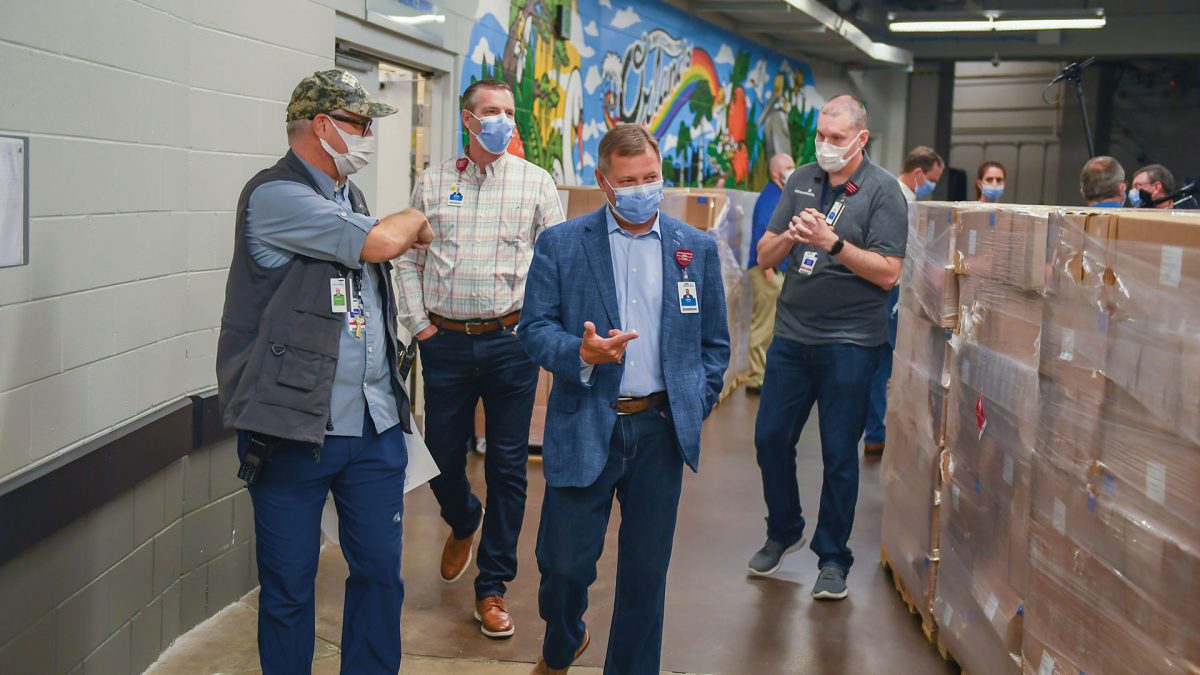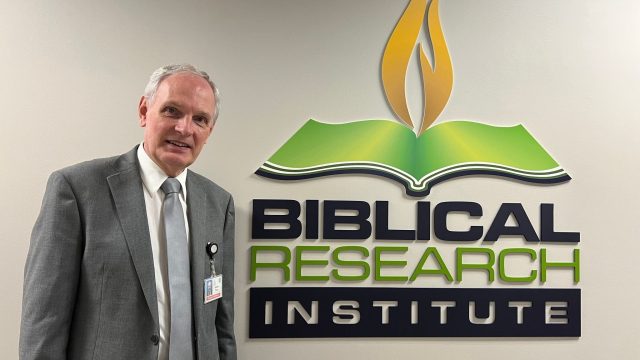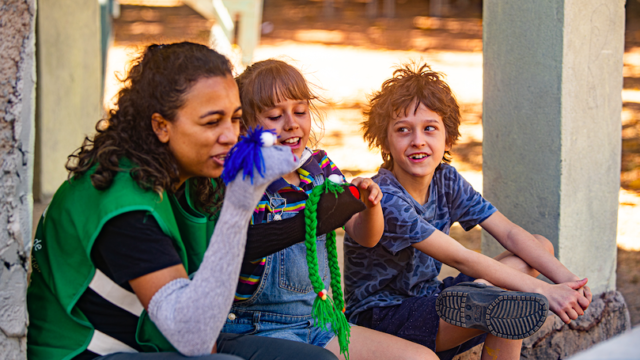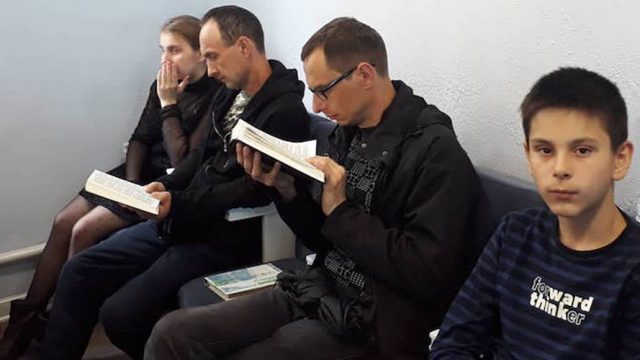A major newspaper recently quoted an emergency room physician as saying, “We never trained to see this much death.” What do you do when the scale of mortality is this big?

Adventist hospitals, clinics, and health systems around the world have struggled to respond to the enormous international health crisis of the COVID-19 pandemic. Adventist World editor Bill Knott recently sat down with Terry Shaw, president/CEO of AdventHealth, the largest Adventist and the largest Protestant health-care system in the world, to talk about delivering uniquely Adventist health care under emergency circumstances.—Editors.
KNOTT: Unlike the biblical story of Joseph and the famines predicted for Egypt, your health system couldn’t know 18 months ago that a great crisis was coming. What did AdventHealth already have in place that allowed you to navigate through the pandemic?
SHAW: Like all health-care organizations, we prepare and we process for the unknown. We have drills for the mass influx of patients. We’re used to getting ready for the immediate and the emergent, but no health system could ever be ready for a worldwide pandemic. I’m especially proud of our clinical team and the epidemiologists who worked overtime and were critical to our planning. Without them, this pandemic would have been an even harder experience. Beginning in March of 2020, as we watched the crisis unfold in Italy and then in New York, they reached out to doctors in both places to find out what was working as the world struggled to understand this new disease. They prepared a very comprehensive COVID-19 best-practice process that we socialized across the company—medications, patient care, resources. That amazing work by our clinicians drove down mortality rates across our system.
The COVID-19 pandemic has been a huge global emergency, and it has also been a very personal story. Talk to me for a moment about what it’s like to be leading a massive health team, but also experiencing the effects of the pandemic near at hand.
Losing more than 3.7 million people worldwide, including 600,000 in the country where AdventHealth operates, is an enormously sobering and difficult reality. Everyone knows someone who has been terribly impacted by this pandemic. Throughout history people have lived through many tough times. I remember my great-grandparents and my grandparents talking about the influenza crisis of 1918-1919, and the trauma associated with two world wars. This pandemic is the testing time of our generation, and it’s going to be remembered forever for the immense losses of life, for the isolation and loneliness it created, and for protections we all had to agree to live with to make it through. When I look at the past 16 months, it almost seems surreal.
A major newspaper recently quoted an emergency room physician as saying, “We never trained to see this much death.” What do you do when the scale of mortality is this big?
Our team members are trained to care for patients so they can get better and go home. People choose health care as a career, so they’re able to help others get well. But we don’t train for this amount of death and dying on a daily basis. It’s a terrible thing to watch those you care for succumb to disease day after day, week after week, month after month. We’ve had hundreds— thousands—of COVID unit workers who are doing their best to give excellent care to very sick people. But these front-line workers also have the strain of trying to make sure their own families are safe— that they don’t somehow bring the coronavirus to those they love. The mental and emotional strain on our team members has been tremendous. Couple that with a society that doesn’t necessarily appreciate the sacrifice these health-care workers are making, and it’s been a real emotional drain for health-care workers.
Many experts have talked about the pandemic in military terms. After months of fighting the disease and caring for the wounded, does that language resonate with you?
Our team members are called “front-line workers” for a reason. And whether that’s inpatient care, outpatient care, or one of our multiple vaccination sites, it’s a war we’re fighting on many fronts. You don’t do just one thing to win a war. You plan, you resource, you deploy, you perform your mission—in dozens, even hundreds, of places. Our whole health system in one sense became “front line.”
You’ve undoubtedly heard many compelling stories from the 85,000 employees of AdventHealth. Which ones moved you most?
At several of our acute-care sites, elderly couples—one spouse in the hospital and one not—arrived at a sixtieth anniversary and couldn’t be together. So employees brought one spouse down to where they could put their hand against the glass to “touch” their loved one on their special day. Employees bought iPads so hospitalized patients who didn’t have a device could talk to their families. Other AdventHealth workers visited patients’ homes after they were discharged to make sure they were OK because they knew the patient was living alone.
When you became president of AdventHealth in 2016, you said in your first major address that “no patient is ever discharged from our care.” That was—that is—a remarkably Adventist approach to health care. What does it mean in the context of COVID-19?
That commitment to whole-person care caused us to innovate during this crisis. Among other things, we put up a COVID hotline and staffed it with people who understand that commitment. You can’t imagine the contacts we received—people all over the globe asking for help in understanding or treating COVID-19. Technology allowed us to continue the caregiving process for those we discharged with a link to the home: someone would always be checking on you after you left our facility. When our hospitals in some regions were crowded to capacity, we began a system of home monitoring of COVID patients, with as many as 800 patients at a time being electronically monitored in their homes.
Many people assume big health-care systems are all about patient volume, and turnover, and bottom-line finances. How has AdventHealth made good on your pledge to stay engaged with those who seek your care?
First, if we’re going to care for people—body, mind, and spirit—we have to lean into doing that better than we did yesterday. For us, that means rolling out programs that meet consumers where they are in terms of their mental, emotional, and spiritual needs.
Second, we need to see our workforce through the right lens and take care of them accordingly. At AdventHealth we see our workforce as team members, not just “employees.” We leaned into our service standards–Keep Me Safe, Love Me, Make It Easy, and Own It—to guide our decisions on supporting our team members and our patients.
You’ve said that caring for the whole person includes caring for your team members just as fully. What steps has your system taken to watch out for their mental and emotional health during this pandemic?
One of the first things we did was to turn our twice-a-year employee feedback process into an ongoing , everyday process. Team members can tell us what they need, how they’re feeling about their work at any time. We’re also doing monthly reviews of how our employees are coping, where their needs are, and what we can do better to support them. In addition, we developed programs to guarantee our team members employment through the worst parts of the pandemic and specifically the times that we shut down some of our services. Our HR and IT teams created a redeployment app for team members to find other areas within the organization to work. We also invested in providing hotel rooms for those who worked in COVID-exposed units; we provided child care and expanded our benefits, including additional mental health services. All of this provided stability for our team members and for the communities we serve.
I’ve heard about an internal campaign designed to “get behind the mask” of employee mental health during the pandemic. Tell me about that.
We ran a campaign called “Fine Is Not Fine.” When you ask me, “Terry, how are you doing?” I’ll generally say, “Fine.” For us, however, that word “fine” hides a lot of problematic realities in many employee lives. Whether they recognize it or not, employees working through this prolonged pandemic are probably not “fine.” “Fine” could be a cover for a host of emotions brewing beneath the surface. And so we encouraged employees to watch out for each other—to make sure their colleagues are OK. All employees in our system can get access to free mental health care if they feel they need it— if the stresses in their professional and personal lives require it.
The logistics of coordinating personnel and resources at 50 hospitals and hundreds of outpatient and senior care facilities in 10 U.S. states must have taxed every system you have. What did you learn about redeploying human and material resources during this crisis?
We’ve watched the COVID-19 pandemic surge and ebb around the world and in the U.S. at different times in different places. There were moments when we needed 50 people to relocate to a community temporarily to set up a vaccination tent, and we found them. We reached out to employees, and many of them actually checked our internal websites and volunteered to go where they were needed— they redeployed themselves in an efficient, organized way. You may have heard we turned the entire Orlando downtown basketball arena into our national centralized warehouse. It took hundreds of people to make that work. We transferred nurses across 10 U.S. states to pandemic hotspots where they were needed. All of this was organized through our COVID-19 command center. The lines of authority out of that command center were very well understood and very well defined. If I needed to wear jeans today and bring my truck to haul supplies from one place to the next, that’s what I did.
You actually did things like that yourself?
Yes, and everybody else around here. When you’ve got team members like that, you stay loyal to them. We didn’t lay anybody off in the process. We lost $US700 million in the first two and a half months of the pandemic, but fortunately we had borrowed $US1 billion just one month before the crisis hit. Once we were able to get back to work, we’ve been able pay it all back. Last year obviously wasn’t what a CEO would like it to be, but, with God’s grace, it wasn’t insurmountable. It was a great blessing from the Lord to have an amazing team and a solid balance sheet as we moved through this pandemic.
Ultimately, Terry, you’re the one casting a vision for the largest Protestant healthcare system in the world. What message are you trying to communicate as we watch this international crisis begin to ease in many places?
Bill, regardless of who you are or the type of care you need, our responsibility is to be prepared to care for you as a whole person—body, mind, and spirit. Our watchword every day is simple: “God, grant us the wisdom, the compassion, and the resources to care for each person as if there was no other person to care for.”








